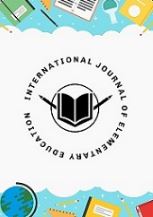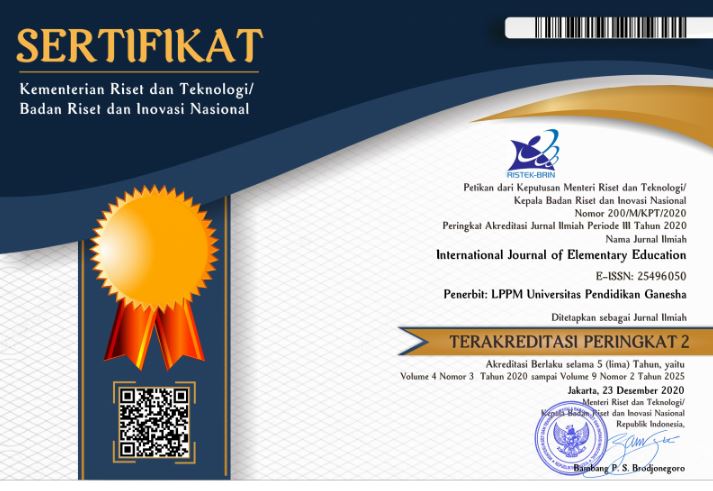Interactive Multimedia on Learning Achievement of the Digestive System in Elementary School
DOI:
https://doi.org/10.23887/ijee.v6i4.53357Keywords:
Multimedia interactive, science, digestive system, elementary schoolsAbstract
The lack of careful selection of science learning media for fifth grade elementary school encourages this research. The aim of this project is to create a legitimate, useful and efficient interactive multimedia (MI) product for 5th grade science classes in elementary schools. Development research is the methodology used. The ADDIE development model is used in this study. The type of data taken in this study is primary data. The subjects of this study were 21 students and teachers of class V in an elementary school. Instrument validation charts, language instruments, material instruments, practicality sheets, and test question sheets are among the data collection tools. The data analysis technique is adapted to the data collection equipment. The validation sheet was used to perform the validation analysis, which was carried out using a Likert scale. The research findings show positive results in terms of validity, practicality, and effectiveness of the developed interactive multimedia. This study resulted in three findings, namely: (1) MI is valid at an average value of 4.7 with very valid qualifications (2) practical at an average value of 89.03 very practical qualifications and (3) effective in increasing student learning success at grades an average of 94.8 (95% success). The conclusion of this study is that the MI Digestive System is effective in increasing student achievement.
References
Abbasi, S., Moeini, M., Shahriari, M., Ebrahimi, M., & Khoozani, E. K. (2018). Designing and manufacturing of educational multimedia software for preventing coronary artery disease and its effects on modifying the risk factors in patients with coronary artery disease. Electronic Journal of General Medicine, 15(3), 1–6. https://doi.org/10.29333/ejgm/85942.
Al Sultan, A., Henson, H., & Lickteig, D. (2021). Assessing preservice elementary teachers’ conceptual understanding of scientific literacy. Teaching and Teacher Education, 102, 103327. https://doi.org/10.1016/j.tate.2021.103327.
Aldoobie, N. (2015). ADDIE Model. American International Journal of Contemporary Research, 5(6). www.aijcrnet.com/journals/Vol_5_No_6_December_2015/10.pdf.
Anif, S., Sutopo, A., & Prayitno, H. J. (2020). Lesson study validation: Model for social and natural sciences teacher development in the implementation of national curriculum in Muhammadiyah schools, Indonesia. Universal Journal of Educational Research, 8(1), 253–259. https://doi.org/10.13189/ujer.2020.080132.
Baquier Orozco, R., Barraza Castillo, R. I., & Husted Ramos, S. (2020). Neoaltar: An interactive multimedia day of the dead experience. Heliyon. https://doi.org/10.1016/j.heliyon.2020.e03339.
Branch, R. M. (2010). Instructional design: The ADDIE approach. In Instructional Design: The ADDIE Approach. https://doi.org/10.1007/978-0-387-09506-6.
El Islami, R. A. Z., & Nuangchalerm, P. (2020). Comparative study of scientific literacy: Indonesian and thai pre-service science teachers report. International Journal of Evaluation and Research in Education, 9(2), 261–268. https://doi.org/10.11591/ijere.v9i2.20355.
Eliyasni, R., Kenedi, A. K., & Sayer, I. M. (2019). Blended Learning and Project Based Learning: The Method to Improve Students’ Higher Order Thinking Skill (HOTS). Jurnal Iqra’ : Kajian Ilmu Pendidikan, 4(2), 231–248. https://doi.org/10.25217/ji.v4i2.549.
Fawley, K. D., Stokes, T. F., Rainear, C. A., Rossi, J. L., & Budd, K. S. (2020). Universal TCIT Improves Teacher–Child Interactions and Management of Child Behavior. Journal of Behavioral Education, 29(4), 635–656. https://doi.org/10.1007/s10864-019-09337-6.
Fitria, Y., Helsa, Y., Nirwana, H., & Zulkarnaini, A. P. (2018). The integration of science and math. Journal of Physics: Conference Series, 1088. https://doi.org/10.1088/1742-6596/1088/1/012041.
García, E. G., Magaña, E. C., & Ariza, A. C. (2020). Quality education as a sustainable development goal in the context of 2030 agenda: Bibliometric approach. Sustainability (Switzerland), 12(15), 1–18. https://doi.org/10.3390/SU12155884.
Ghofur, A., & Youhanita, E. (2020). Interactive Media Development to Improve Student Motivation. IJECA (International Journal of Education and Curriculum Application), 3(1), 1–11. https://doi.org/10.31764/ijeca.v3i1.2026.
Gustinasari, M., Lufri, & Ardi. (2017). Pengembangan Modul Pembelajaran Berbasis Konsep Disertai Contoh pada Materi Sel untuk Siswa SMA. Bioeducation Journal, 1(1), 2354–8363. http://ejournal.unp.ac.id/index.php/bioeducation/article/view/7154.
Helsa, Y., Ariani, Y., & Kenedi, A. (2021). Digital Class Model in Mathematics Learning in Elementary School Using Social Learning Network Schoology. Advances in Social Science, Education and Humanities Research, 382(Icet 2019), 2016–2019. https://doi.org/10.4108/eai.4-11-2020.2304599.
Indriani, A. (2016). Pengaruh Motivasi Belajar Siswa Kelas V Terhadap Prestasi Belajar Matematika Di Sd Negeri Bejirejo Kecamatan Kunduran Kabupaten Blora. JIPM (Jurnal Ilmiah Pendidikan Matematika), 4(2), 134. https://doi.org/10.25273/jipm.v4i2.848.
Kalkan, Ö. K., Altun, A., & Atar, B. (2020). Role of teacher-related factors and educational resources in science literacy: An international perspective. Studies in Educational Evaluation, 67(August). https://doi.org/10.1016/j.stueduc.2020.100935.
Kiswanto, A. (2017). The Effect Of Learning Methods And The Ability Of Students Think Logically To The Learning Outcomes On Natural Sciences Of Grade Iv`S Student. Advances in Social Science, Education and Humanities Research, 118, 1040–1046. https://doi.org/10.2991/icset-17.2017.168.
Magdalena, I., Hidayah, A., & Safitri, T. (2021). Analisis Kemamuan Peserta Didik pada Ranah Kognitif, Afektif, Psikomotorik Siswa Kelas II B SDN Kunciran 5 Tangerang. Jurnal Pendidikan Dan Ilmu Sosial, 3(1), 48–62. https://doi.org/10.36088/nusantara.v3i1.1167.
Mtsi, N. (2021). Examining The Support Given To Teachers To Promote Science Learning And Science Literacy In Selected South African Schools. PONTE, 77(4), 56–75. https://doi.org/10.21506/j.ponte.2021.4.4.
Mutohhari, F., Sofyan, H., & Nurtanto, M. (2021). Technological Competencies: A Study on the Acceptance of Digital Technology on Vocational Teachers in Indonesia. Proceedings of the 1st International Conference on Law, Social Science, Economics, and Education, ICLSSEE 2021, 1–11. https://doi.org/10.4108/eai.6-3-2021.2305971.
Nurtanto, M., Sofyan, H., Fawaid, M., & Rabiman, R. (2019). Problem-based learning (PBL) in industry 4.0: Improving learning quality through character-based literacy learning and life career skill (LL-LCS). Universal Journal of Educational Research, 7(11), 2487–2494. https://doi.org/10.13189/ujer.2019.071128.
Purwani, E., Hasan, K., & Alamsyah, H. (2021). Peningkatan Hasil Belajar dengan Menggunakan Model Problem Based Learning Pendekatan SSTEAM Pada Siswa. 3(3), 296–302. https://doi.org/10.26858/tpj.v2i3.26764.
Qurat-ul-Ain, quratulain raja15@gmail com, Shahid, F., Aleem, M., Islam, M. A., Iqbal, M. A., & Yousaf, M. M. (2019). A review of technological tools in teaching and learning computer science. Eurasia Journal of Mathematics, Science and Technology Education, 15(11). https://doi.org/10.29333/ejmste/109611.
Rachmadtullah, Zulela M, Sumantri, M. S. (2018). Interactive Multimedia Development Based on Scientific Approach to Civic Education Subjects in Elementary School. Interciencia Journal, 43, 13–21. https://www.researchgate.net/profile/Reza-Rachmadtullah/publication/326570674_Interactive_Multimedia_Development_Based_on_Scientific_Approach_to_Civic_Education_Subjects_in_Elementary_School/links/5b5697dca6fdcc8dae3fcf08/Interactive-Multimedia-Development-Based-on-Scientific-Approach-to-Civic-Education-Subjects-in-Elementary-School.pdf.
Rachmadtullah, R., Yustitia, V., Setiawan, B., Fanny, A. M., Pramulia, P., Susiloningsih, W., Rosidah, C. T., Prastyo, D., & Ardhian, T. (2020). The Challenge of Elementary School Teachers to Encounter Superior Generation in the 4.0 Industrial Revolution: Study Literature. International Journal of Scientific and Technology Research, 9(4), 1879–1882. https://www.researchgate.net/profile/Reza-Rachmadtullah/publication/340886839_The_Challenge_Of_Elementary_School_Teachers_To_Encounter_Superior_Generation_In_The_40_Industrial_Revolution_Study_Literature/links/5ea2b9a492851c87d1b1066f/The-Challenge-Of-Ele.
Rahmatina, Kenedi, A. K., Eliyasni, R., & Fransyaigu, R. (2019). Jigsaw using animation media for elementary school. Journal of Physics: Conference Series, 1424(1). https://doi.org/10.1088/1742-6596/1424/1/012027.
Rosalina, S. S., & Suhardi, A. (2020). Need Analysis of Interactive Multimedia Development With Contextual Approach on Pollution Material. INSECTA: Integrative Science Education and Teaching Activity Journal, 1(1), 93. https://doi.org/10.21154/insecta.v1i1.2107.
Saputri, D. Y., Rukayah, R. R., & Indriayu, M. I. (2018). Integrating Game-based Interactive Media as Instructional Media: Students’ Response. Journal of Education and Learning (EduLearn), 12(4), 638–643. https://doi.org/10.11591/edulearn.v12i4.8290.
Sartono, E. K. E., Ambarsari, R., & Herwin, H. (2022). Interactive multimedia based on Indonesian cultural diversity in Civics learning in elementary schools. Cypriot Journal of Educational Sciences, 17(4), 1192–1203. https://doi.org/10.18844/cjes.v17i4.7136.
Sendurur, E. (2018). The Pedagogical Beliefs and Instructional Design Practices: Pre-Service IT Teachers’ Case. Egitim Arastirmalari - Eurasian Journal of Educational Research, 2018(75), 59–80. https://doi.org/10.14689/ejer.2018.75.4.
Sharon, A. J., & Baram-Tsabari, A. (2020). Can science literacy help individuals identify misinformation in everyday life? Science Education, 104(5), 873–894. https://doi.org/10.1002/sce.21581.
Sherlyane Hendri, S., Hendri, S., Kiswanto Kenedi, A., Helsa, Y., & Anita, Y. (2019). Elementary School Teacher Ability in Using Application Technology for Mathematics Learning Assessment in the 2013 Curriculum. Advances in Social Science, Education and Humanities Research, 382(Icet), 446–449. https://doi.org/10.2991/icet-19.2019.112.
Siang, J. L., Sukardjo, M., Salenussa, B. J. M., Sudrajat, Y., & Khasanah, U. (2020). Pengaruh Model Pembelajaran dan Kemampuan Berpikir Kreatif Terhadap Hasil Belajar IPA Siswa SMP. JTP - Jurnal Teknologi Pendidikan, 22(1), 40–52. https://doi.org/10.21009/jtp.v22i1.15329.
Sinyanyuri, S., Utomo, E., Sumantri, M. S., & Iasha, V. (2022). Literasi Sains dan Asesmen Kompetensi Minimum (AKM): Integrasi Bahasa dalam Pendidikan Sains. Jurnal Basicedu, 6(1), 1331–1340. https://doi.org/10.31004/basicedu.v6i1.2286.
Sudana, I. P. A., & Wesnawa, I. G. A. (2017). Penerapan Model Pembelajaran Kooperatif Tipe Stad Untuk Meningkatkan Hasil Belajar Ipa Siswa Kelas Ii Sekolah Dasar. Jurnal Ilmiah Sekolah Dasar, 1(1), 1–8. https://doi.org/10.33578/jpfkip.v7i1.5359.
Suryanti, Ibrahim, M., & Lede, N. S. (2018). Process skills approach to develop primary students’ scientific literacy: A case study with low achieving students on water cycle. IOP Conference Series: Materials Science and Engineering, 296(1). https://doi.org/10.1088/1757-899X/296/1/012030.
Susanto, H. A., Hobri, & Nugrahaningsih, T. K. (2021). Developing a handbook on multimedia integration in mathematics teaching for indonesian primary school students. International Journal of Education in Mathematics, Science and Technology, 9(2), 236–251. https://doi.org/10.46328/IJEMST.1550.
Suwarti, S., Restu, R., & Hidayat, H. (2019). Interactive Multimedia Development in Social Sciences Subject of Disaster Material at Grade IV SDN. (Public Elementary School) No.024183 East Binjai on 2017/2018. Budapest International Research and Critics in Linguistics and Education (BirLE) Journal, 2(1), 216–232. https://doi.org/10.33258/birle.v2i1.211.
Virkkula, E. (2020). Evaluating motivational characteristics in vocational music education within the perspective of self-determination theory. Empirical Research in Vocational Education and Training, 12(1), 1. https://doi.org/10.1186/s40461-020-00098-5.
Wahyuni, L. T. S., Japa, I. G. N., & Rati, N. W. (2020). Correlation of Reading Interests and Learning Motivation Toward Science Learning Outcomes. Jurnal Ilmiah Sekolah Dasar, 4(3), 484. https://doi.org/10.23887/jisd.v4i3.25376.
Wiryanto, W. (2020). Proses Pembelajaran Matematika Di Sekolah Dasar Di Tengah Pandemi Covid-19. Jurnal Review Pendidikan Dasar : Jurnal Kajian Pendidikan Dan Hasil Penelitian, 6(2), 125–132. https://doi.org/10.26740/jrpd.v6n2.p125-132.
Yalvema Miaz, Y., Miaz, Y., Kiswanto Kenedi, A., Wachyunaldi Monfajri, S., & Helsa, Y. (2019). Educative Learning Media for Elementary School Students. Advances in Social Science, Education and Humanities Research, 382(Icet), 722–727. https://doi.org/10.2991/icet-19.2019.173.
Yeo, M. M. L. (2021). Social media and social networking applications for teaching and learning. European Journal of Science and Mathematics Education, 2(1), 53–62. https://doi.org/10.30935/scimath/9400.
Zulkifli, Z. (2018). Upaya Guru Mengembangkan Media Visual dalam Proses Pembelajaran Fiqih di MAN Kuok Bangkinang Kabupaten Kampar. Al-Hikmah: Jurnal Agama Dan Ilmu Pengetahuan, 14(1), 18–37. https://doi.org/10.25299/al-hikmah:jaip.2017.vol14(1).1170.
Zuryanty, Kenedi, A. K., Chandra, R., Hamimah, & Fitria, Y. (2019). Problem based learning: A way to improve critical thinking ability of elementary school students on science learning. Journal of Physics: Conference Series, 1424(1). https://doi.org/10.1088/1742-6596/1424/1/012037.
Downloads
Published
How to Cite
Issue
Section
License
Copyright (c) 2022 Yanti Fitria

This work is licensed under a Creative Commons Attribution-ShareAlike 4.0 International License.
Authors who publish with the International Journal of Elementary Education agree to the following terms:
- Authors retain copyright and grant the journal the right of first publication with the work simultaneously licensed under a Creative Commons Attribution License (CC BY-SA 4.0) that allows others to share the work with an acknowledgment of the work's authorship and initial publication in this journal.
- Authors are able to enter into separate, additional contractual arrangements for the non-exclusive distribution of the journal's published version of the work (e.g., post it to an institutional repository or publish it in a book), with an acknowledgment of its initial publication in this journal.
- Authors are permitted and encouraged to post their work online (e.g., in institutional repositories or on their website) prior to and during the submission process, as it can lead to productive exchanges, as well as earlier and greater citation of published work. (See The Effect of Open Access)









